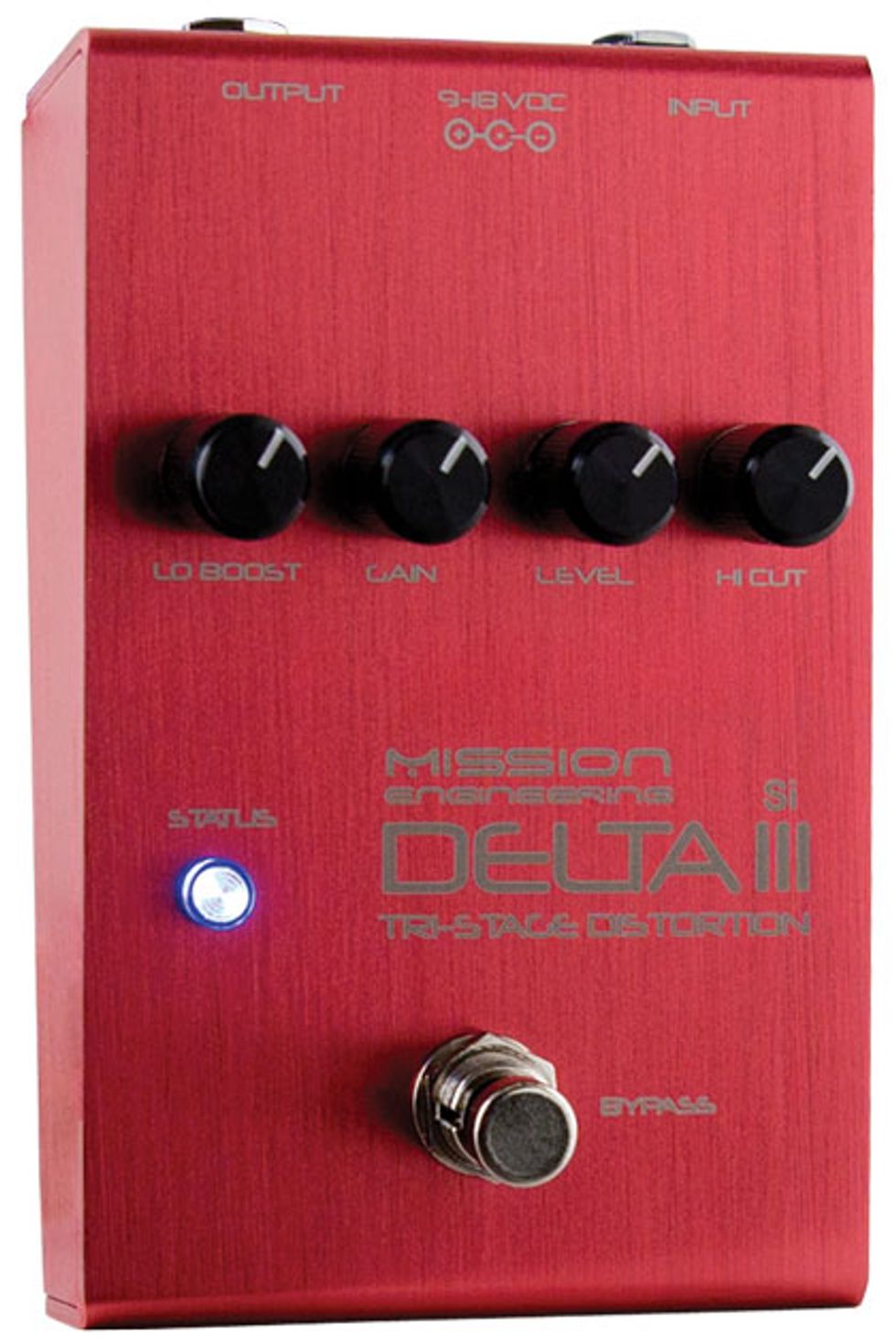A streamlined approach for boosted-to-fuzzy dirt tones.
A pedal capable of distortion, boost and fuzz isn’t revolutionary. But considering how many of us string together endless combinations of those three pedal types on our boards, a streamlined approach is always intriguing. Mission Engineering’s Delta III Si isn’t a three-in-one box with independent fuzz and overdrive circuits cascading into each other, but a three-transistor analog dirt unit that can go from transparent boost to ballsy vintage fuzz with the twist of the gain knob. (The pedal employs silicon transistors, though Delta also offers a germanium version.)
Delta, this is Mission Control
You control the Delta III Si via four knobs. Lo cut and hi cut trim bass and treble, respectively. Level is a master volume control. Gain is the key to the Delta III’s varied personality, moving from boost to overdrive to full-throttle fuzz across its range. The footswitch is a quiet, soft-touch relay.
The lightweight, brushed-aluminum enclosure houses two printed circuit boards. There’s no 9V battery option, though you can power the Delta III Si with 7.5V-18V power supplies for the option of varied headroom. The pedal works best with a dedicated power supply—a daisy-chain supply can make the Delta generate a wall of locust chatter when the effect is engaged. But with the right power arrangement the Delta is extremely quiet at all but the most extreme gain settings.
Call in the Firepower
Mission Engineering touts the Delta III’s “friendliness” with other pedals. As with many fuzz pedals, my first inclination was the place it early in my signal chain, but I got the best results when I put it after an overdrive (an Amptweaker Tight Drive Pro). The overdrive excited Delta III’s crunchy output rather than adding stifling compression
Ratings
Pros:
Easy access to wide-ranging tones.
Cons:
No battery option. Daisy-chains power supplies are a no-no.
Tones:
Ease of Use:
Build/Design:
Value:
Street:
$199
Mission Engineering Delta III Si Tri-Stage Distortion
missionengineering.com
With my Telecaster and the Delta III’s gain at 11 o’clock, I got Tube Screamer-like overdrive right at the cusp of crunch—an excellent setting for pushing a saturated amp over the edge. Note clarity is exceptional, and the pedal responds dynamically to changes in picking intensity. Digging in deep gives a blistering, amp overdrive-like edge. A lighter touch adds sparkling highlights and high-mid detail to chords and slower leads. However, that extra note definition means trebly guitars can sound super bright. That’s when the hi cut knob becomes invaluable. Setting it around 1 o’clock left plenty of room for my Telecaster’s top end to breathe, but kept shrieking feedback at bay when I stacked on extra gain.
With a Gibson Les Paul and an 18V adaptor, I checked out the available headroom. The higher voltage seemed to expand the tonal range of the darker humbuckers. The extra headroom meant more definition at high-gain settings. With gain at 3 o’clock and lo cut around 11 o’clock, I got a gritty, honky Les Paul drawl. Played with a slide, it was a straight shot of Duane Allman bliss. Decreasing lo cut at high-gain settings really fills out the bottom end—a cool tone option for the pedal’s fuzzier realms. And while the Delta doesn’t quite nail the brawn and sustain of a Big Muff, it’s still perfect for chunky ’70s hard rock power chords and stoner rock grind. You can readily move from fuzzier zones to civilized overdrive by trimming the guitar’s output. (This feels especially responsive with single-coils.)
The Verdict
The Delta III is a versatile dirt box that can wear many disguises. It’s a cool choice if you need one pedal to produce boost, overdrive and distortion tones, especially for travelling players requiring streamlined setups. It’s transparent enough to add definition and oomph to dirty amps without turning your tone into a saturated blur.The lack of switching options may limit the Delta III’s onstage usefulness for some players. But the pedal excels as a boost/distortion/overdrive you can quickly and intuitively tailor to suit varying guitars and amps. Given how readily it delivers everything from smooth crooning to fire and brimstone, the $199 street price is fair.



